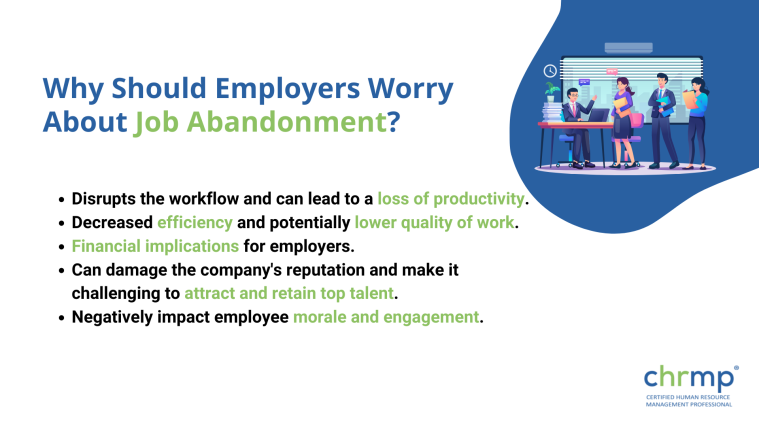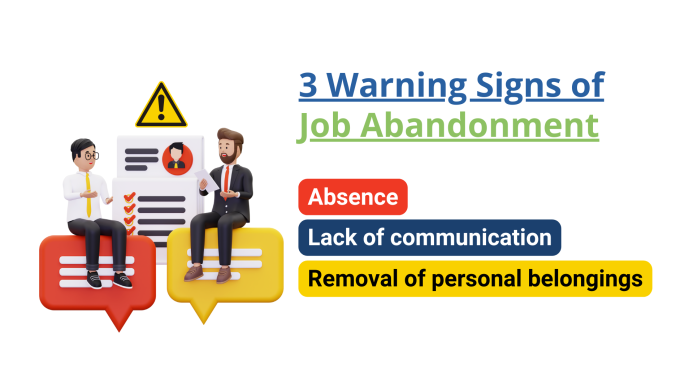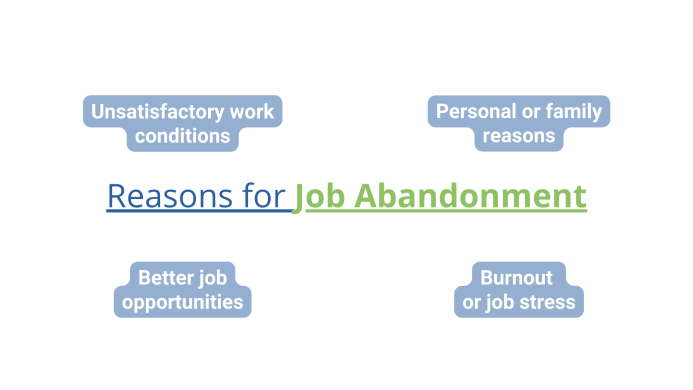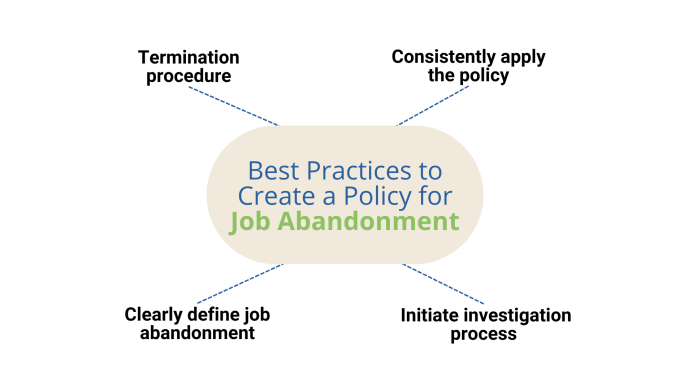

Job abandonment affects many people in the business world and can be a very negative, challenging and stressful experience.
But despite the difficulties, these are opportunities to grow, learn, develop and find new paths to professional and personal success.
So buckle up and learn how to navigate through the world of job abandonment with a fresh, optimistic outlook.
Let’s jump right in.
Job abandonment is a complex issue which affects both the employee and the employer. On the employee side, job abandonment can result in income loss and difficulty finding new employment elsewhere, especially if the employee has a history of leaving jobs without proper notice. Sometimes, it can also damage the employee’s reputation and make it harder to secure future job offers.
Employers should be worried about job abandonment due to the negative impacts it can have on their organization.
When an employee abandons their job, it disrupts the workflow and can lead to a loss of productivity.

Other employees may have to take on additional responsibilities or cover the abandoned tasks, resulting in decreased efficiency and potentially lower quality of work. This can have a ripple effect throughout the organization, causing delays in project timelines, missed deadlines, and a decline in customer satisfaction.
Moreover, job abandonment can have financial implications for employers. The cost of recruiting and training a replacement can be significant, not to mention the potential loss of institutional knowledge and expertise that the departing employee may have possessed.
Additionally, frequent instances of job abandonment can damage the company’s reputation and make it challenging to attract and retain top talent.
Furthermore, job abandonment can negatively impact employee morale and engagement.
When employees witness their colleagues leaving abruptly, it can create a sense of uncertainty and instability, leading to decreased motivation and loyalty. It may also erode trust and confidence in the organization’s leadership and management.
Job abandonment can be a very confusing and stressful situation even for employers, as it often comes without warning, out of the blue and can disrupt the workplace’s day-to-day routine. However, sure tell-tale signs can indicate that an employee has abandoned their job. Here are three tell-tale signs of job abandonment:

Suppose the employee suddenly stops coming to work for a prolonged period or continually at commonplace intervals without prior notice or explanation. In that case, it may be a sign that they may never turn up again.
If an employee removes their items from the workplace, it indicates that the employee may have decided to leave their job or is preparing to do so.
If an employee is unresponsive to calls, emails, or texts from their employer or coworkers, it may be a sign that they might have abandoned their job. This lack of communication is a ruse to avoid previous employers and work mates, which should eventually, after a specific span, be construed as job abandonment.
The employee might be sick, or there might be some emergency in the family. Nevertheless, these are common indicators employers should be aware of and monitor closely to determine employee status.
Here are four common reasons for job abandonment:

Employees may abandon their job if they are unhappy with the work environment, including factors such as long hours, poor management, lack of growth opportunities, career enhancement, inadequate pay and improper work-life balance.
Employees may abandon their job due to personal or family circumstances, such as illness, caregiving responsibilities, or relocation.
Employees may leave their current job if they receive a better job offer elsewhere, with higher pay, more benefits, better working conditions and better work-life balance.
Job stress and burnout are fast becoming a significant causes for concern as employees abandon their jobs when they feel overwhelmed and unable to cope with the job’s demands or exhausting work schedules.
It’s important to note that job abandonment can have several causes and may be influenced by multiple factors. Understanding the reasons behind job abandonment can help employers address the underlying issues and prevent them from happening.
Preventing job abandonment requires a proactive approach and endeavour. A commitment to creating a positive work environment certainly saves the day. Here are some steps that employers can take to reduce the likelihood of job abandonment:
Regular employee surveys can help identify any dissatisfaction among the workforce or stress factors building up in the workplace and allow employers to address them before they lead to job abandonment.
Absenteeism should be discouraged. Employers should ensure that their attendance policy is communicated to all employees and that they understand the consequences of abandoning their job without proper notice. Some sort of withdrawal of privileges, if appropriate notice is not given, is called for.
Addressing performance issues in a timely and supportive manner can help prevent employees from feeling disengaged and ultimately abandoning their job, i.e. employee engagement should be carefully gauged, monitored and rewarded appropriately.
Employers should review their leave policies, including vacation, sabbatical, study, sick, and such, to ensure that they are fair, flexible, and supportive of employees’ personal and family needs.
Employers should encourage employees to give proper notice before leaving their job to ensure a smooth transition and maintain positive relationships without any vestiges of acrimony with former employees.
Employers should treat departing employees with respect and professionalism and send them off with good wishes for their future endeavours. This can help maintain positive relationships and prevent any negative publicity and acrimony.
By taking these steps, employers can help create a positive and supportive work environment that reduces the risk of job abandonment and, promotes employee engagement satisfaction, enhances productivity and performance, which will forge a bond of trust between employers and the workforce rather than a work culture strife with acrimonious work strikes, lock-outs and desertions.
Creating a clear policy for job abandonment can help employers manage the situation effectively and ensure consistent treatment of all employees. Here are some best practices you should follow while creating a job abandonment policy:

The policy should clearly define job abandonment and the circumstances under which it can occur, such as extended or continual absences with increasing frequency without notice or communication.
The policy should outline the steps employers should take when they suspect an employee has abandoned their job, including contacting the employee, their kin or parents and gathering information to confirm their status.
Suppose the investigation confirms that the employee has abandoned their job. In that case, the policy should outline the steps the employer should take to formally terminate the employment, including any necessary documentation and procedures.
The policy should be consistently applied to all employees irrespective of bias to ensure fairness and prevent discrimination.
By creating a clear policy for job abandonment, employers can manage the situation consistently and professionally and minimize any friction or negative impact on the workplace. A well-defined policy can provide clarity for employees and help prevent job abandonment from occurring in the first place by fostering an environment of engagement, performance, growth for employees and talent retention, low turnover rates and enhanced productivity for the employers.
What is considered job abandonment?
Job abandonment typically refers to an employee who stops coming to work without notice or explanation and has no intention of returning. This can include extended absences without communication, removing personal belongings from the workplace, and failing to respond to calls, emails, or texts.
Can an employee be terminated for job abandonment?
Yes, an employee can be terminated for job abandonment if the employer has a clear policy in place and the employee has abandoned their job without proper notice or explanation.
What should an employer do if they suspect an employee has abandoned their job?
If an employer suspects an employee has abandoned their job, they should start an investigation process. This may include contacting the employee, gathering information, and confirming their status. If the investigation confirms that the employee has abandoned their job, the employer can proceed with termination.
What are some steps employers can take to prevent job abandonment?
Employers can prevent job abandonment by creating a positive and supportive work environment, conducting regular employee surveys, promoting awareness of attendance policies, addressing performance issues, reviewing leave policies, encouraging proper notice before leaving, and sending off departing employees with good wishes.
In conclusion, job abandonment is a significant issue that can impact the workplace and cause disruption for employers and employees alike. By understanding the common signs, reasons, and steps for preventing and managing job abandonment, employers can take a proactive approach to creating a positive and supportive work environment and reducing the risk of job abandonment.
Having a clear policy and consistently applying it can also help ensure fair and consistent treatment of all employees without bias or discrimination.
The focus should be on creating a positive work culture wherein there is little or no friction, or strife between employees and employers, thus promoting employee engagement, low turnover rates and job abandonment rates to foster a win-win situation for both parties.
© 2007-2025 CHRMP| All Rights Reserved | Powered by Ripples Learning & Research Private Limited
